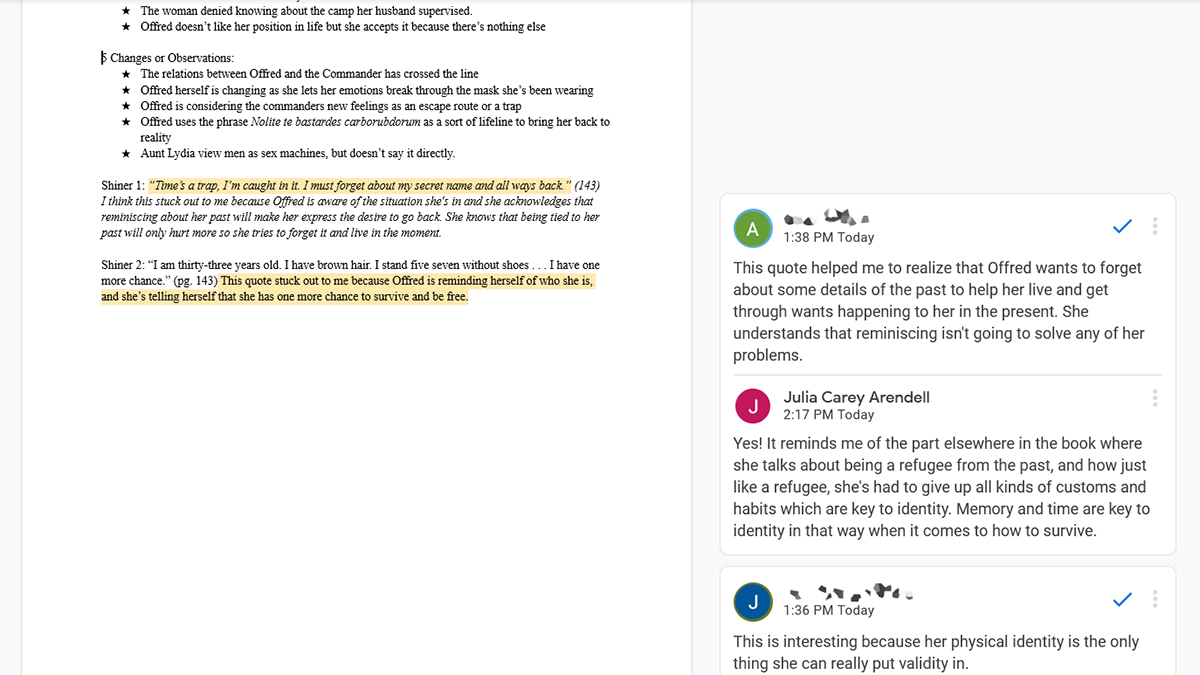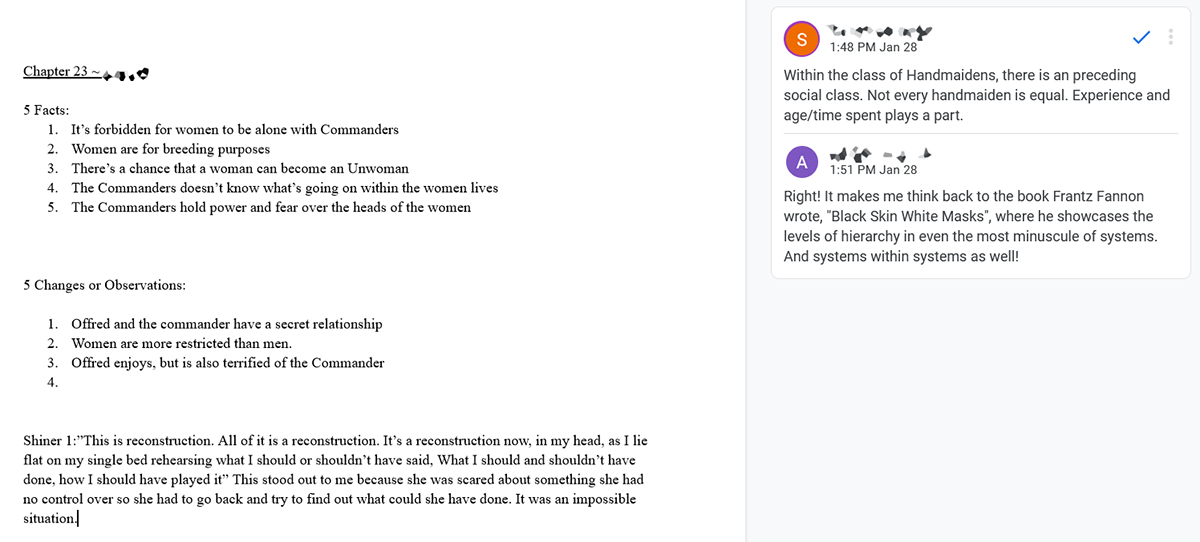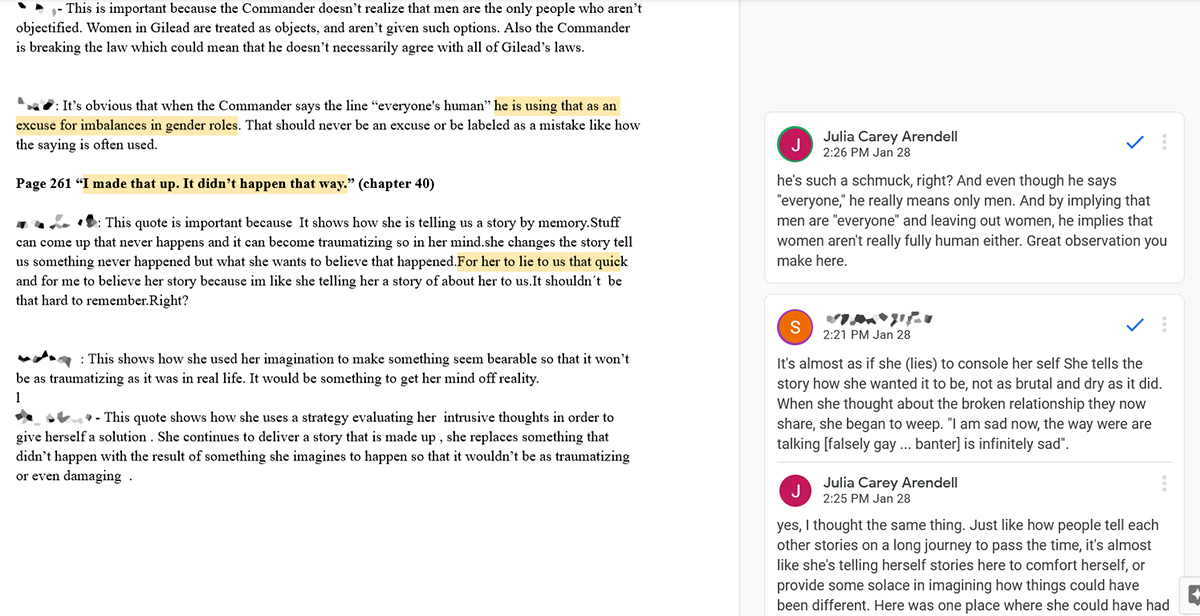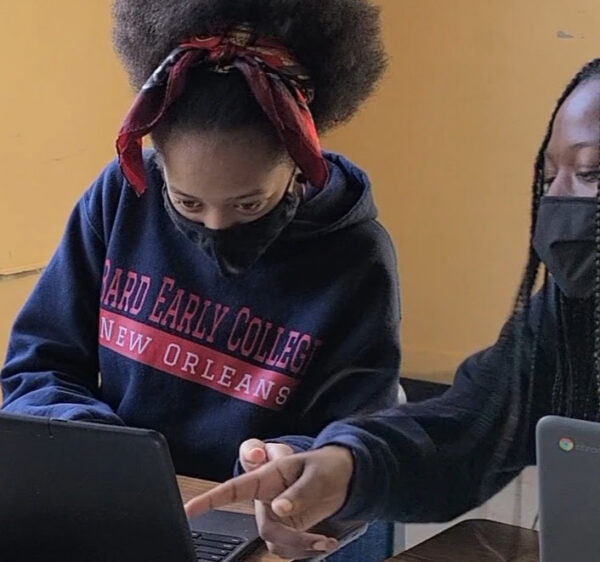In the early college classroom, when I create and dream lesson plans, I also consider soft skills our students can learn or practice that will hopefully buttress them when they transfer to their next college experience, in addition to my goals for the course material. For my Dystopian Fiction course early in the semester, I aimed to build community in the class as the students get to know each other, but also to help them learn how to use each other as resources and build marginalia. We don’t survive or succeed at anything alone, and I spend a lot of time encouraging them to find their people while also building generative study habits to practice with them. We are currently forced to teach in a hybrid format as students cycle in and out of quarantine, so everything I do right now has to have Zoom-able access. So this is a combination lesson that incorporates focused freewriting, dialectical notebooks, sharing, teamwork, and a process write.
1
For this script exploring The Handmaid’s Tale, we had already had two class discussions situating the book and helping them settle into this (not so) foreign world and its rules. For this class, they were to have read through the end of chapter 30.
- We begin with a private free write. Or, they can spend these 3 minutes to collect themselves in whatever way they need to create a favorable and receptive learning environment.
- We also have a community share moment, which in this case was the process sketch they completed at the end of the last class. This was a visual piece, and it also served to include the folx at home in their cameras.
- Then we turned to a Google Doc, which I shared with them, and had these instructions for their groups of 2 or 3. It is important to note that we have had a great deal of disruption on our campus lately, and The Handmaid’s Tale also has very short chapters, and so I wanted to give them some focused time to read, hopefully re-read. This first step may not be necessary for others, but it was right for what our campus needed at the time.
-
- READ your assigned chapter, either out loud or by yourselves. Mark shiners.* (*What’s a shiner? Something that either shines out like a bright light – something that excites you or fires you up, or something that punches you in the face, gives you a figurative black eye, something that really bothers you.) Then come back and work together.
- CAPTURE 5 facts. (These need to be specific to what is happening in that chapter.)
- FIND 5 changes or observations. What has shifted in this chapter? What do you notice?
- Each of you WRITE one shiner* each. Explain why this quote stuck with you.
- COMMENT on each other’s shiner by using the Comment feature: how did your partner’s shiner help you see or think something new?
- We spent some time discussing the difference between facts and observations, defined and clarified my term “shiners” and then did chapter 28 together as a group for an example, before assigning them partners, either in breakout rooms or next to each other in the classroom.
Here’s a small sample of what they came up with:


What I love about this collaborative space is it also allows for me to go into the comments and help steer any comprehension, and I can really see how individual progress is being made through the book by what they know, what they are interpreting, and how they are able to respond to each other.
- At the end of class, we did a process write for 4 minutes: What is something you learned from a peer in this document? How are they thinking about this book that was new for you? I then asked for volunteers to share that writing to lift each other up, but did not require everyone to share.
2
- For the next class, we returned to the Google Doc, but this time I had handpicked five quotes from the next batch of chapters they were to have read and added them to the bottom of the document. I asked them to pick one of the quotes and answer beneath: “Why is this important?” I did not lead them about the word important – to what, to whom, to the story, or to they the reader – I just encouraged them to write what came to them.
- The next step was for them to copy their shiner, one of their comments on a peer’s writing, and the last freewrite on the quote, verbatim into their notebook, and if they were inspired to supplement or edit as this happened, I encouraged them to follow that instinct.
- Read the three pieces of writing together as one passage. Can they add or build upon it?
- Looking for Themes Process Write: What is showing up in your writing? What are you focusing on or thinking about? What is feeling urgent right now?
At this point, they have started building a formative piece of prose, and my hopes are that it would be helpful towards the first essay they have due the following week, and that the last process write helps them reflect and possibly build a thesis statement.
You can see in this last screenshot, while the students are taking this formidable chunk of time to write, I can go into the document and respond to what they have written in an epistolary fashion. In this way I build both accountability and value into the exercise as they know I care about what they are writing and thinking.

